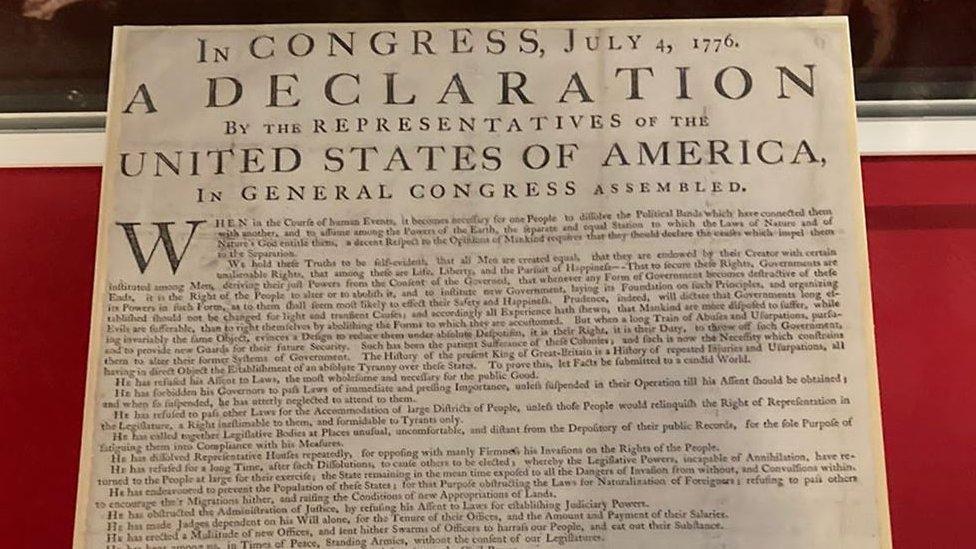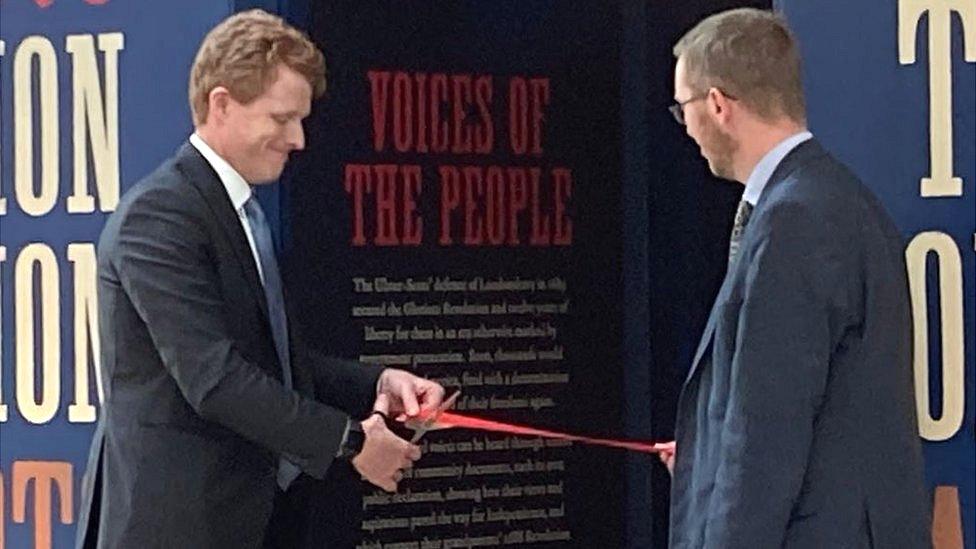US Declaration of Independence on display in Belfast
- Published

Only 26 copies of the declaration remain
One of 26 original remaining copies of the US Declaration of Independence has gone on display in Northern Ireland.
It has been loaned to the Public Record Office Northern Ireland (PRONI) from the UK National Archives for the first time.
It will be part of an exhibition at PRONI to recognise the role of Ulster-Scots people in the declaration.
The US Special Envoy, Joe Kennedy III, was the guest of honour at the exhibition's opening on Thursday.
John Dunlap, the American who printed the first broadside copies of the Declaration of Independence, was born in Strabane, County Tyrone, in 1747.
The broadside copies do not contain the original signatures from the 56 signatories of the 13 colonies.

Strabane-born John Dunlap printed the first broadside copies of the Declaration of Independence
Instead, they were printed by Dunlap as a way to inform the public about the declaration and were put up in public places.
The Belfast News Letter was the first newspaper outside of America to publish the news in August 1776.
At the time, Dunlap's printing house made 200 copies. Only 26 are now known to exist.
The Declaration of Independence set the American Revolutionary War in motion.
It said: "We hold these truths to be self-evident: that all men are created equal; that they are endowed by their Creator with certain unalienable rights; that among these are life, liberty, and the pursuit of happiness."
It is one of the best known and referenced sentences in the English language and had a profound effect on the history of America and other global democracies thereafter.
Matthew Thornton - a signatory for New Hampshire - landed on American soil from the Bann Valley.
Thomas McKean, signatory of Delaware was from Londonderry; George Taylor, signatory for Pennsylvania, emigrated from Antrim along with James Smith.
Edward Rutledge was born in and signatory for South Carolina. His father left Tyrone in 1735.

US Special Envoy Joe Kennedy was the guest of honour at the exhibition opening
Other Declaration signers John Hancock, William Whipple, Robert Paine and Thomas Nelson are also believed to have some links to Northern Ireland.
Ian Crozier, of the Ulster-Scots Agency, said: "This is the biggest achievement that the Ulster-Scots community has made, the biggest impression we have made on the world in terms of bringing forward the birth of the United States."
Ulster-Scots historian Mark Thompson added: "Very often we become very introspective here, but this story is truly international.
"It's amazing to think that a couple of guys who left here when they were children, maybe about nine years old, were so influential that they formed what would become one of the most famous and powerful nations on the planet."
Mr Kennedy was in Northern Ireland as part of President Joe Biden's wider visit north and south of the border to mark the 25th anniversary of the Good Friday Agreement.
The first US special envoy to Northern Ireland for economic affairs, Mr Kennedy ceremoniously cut the ribbon on the new exhibition at PRONI.
The declaration will be on display at PRONI until July.